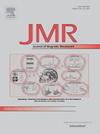A thermally polarized, dissolved-phase 129Xe phantom for quality-control and multisite comparisons of gas-exchange imaging
IF 1.9
3区 化学
Q3 BIOCHEMICAL RESEARCH METHODS
引用次数: 0
Abstract
Harmonizing and validating 129Xe gas exchange imaging across multiple sites is hampered by a lack of a quantitative standard that 1) displays the unique spectral properties of 129Xe observed from human subjects in vivo and 2) has short enough times to enable practical imaging. This work describes and demonstrates the development of two dissolved-phase, thermally polarized phantoms that mimic the in-vivo, red blood cell and membrane resonances of 129Xe dissolved in human lungs. Following optimization, combinations of two common organic solvents, acetone and dimethyl sulfoxide, resulted in two in-vivo-like dissolved-phase 129Xe phantoms yielding chemical shifts of 212.4 ppm and 193.9 ppm. By doping the solutions with iron(iii) acetylacetonate, the longitudinal relaxation time was reduced = 1.2 s for both phantoms at 3 T and 7 T. There was minimal change in chemical shift (+1.58 ppm) and (+1.2 %) over 1 year. In a 2D Dixon-type acquisition with 3 mm2 in-plane resolution, 129Xe dissolved-phase images yielded signal-to-noise ratios 6 and 12 for the RBC and membrane phantoms, respectively. A simple scaling of these phantoms to clinically relevant volumes of several liters would result in an SNR of 7 for the RBC phantom acquired in less than one minute. These findings demonstrate the ability to fabricate robust, quantitative, thermally polarized dissolved-phase phantoms, which will be needed to validate and harmonize gas exchange imaging in multi-site clinical trials.

用于气体交换成像质量控制和多位点比较的热极化、溶解相129Xe模体。
协调和验证跨多个位点的129Xe气体交换成像受到缺乏定量标准的阻碍:1)显示从人体受试者体内观察到的129Xe的独特光谱特性;2)具有足够短的T1时间以实现实际成像。这项工作描述并展示了两种溶解相、热极化幻象的发展,这些幻象模拟了溶解在人肺中的129Xe的体内、红细胞和膜共振。优化后,两种常见的有机溶剂丙酮和二甲亚砜的组合产生了两种体内样的溶解相129Xe幻象,化学位移为212.4 ppm和193.9 ppm。通过在溶液中掺入乙酰丙酮铁(iii),在3 T和7 T时,两种模态的纵向弛豫时间都缩短了T1 = 1.2 s。在1年内,化学位移(+1.58 ppm)和T1(+ 1.2%)的变化最小。在平面内分辨率为3mm2的二维dixon型采集中,129Xe溶解相图像的RBC和膜影的信噪比分别为6和12。将这些幻影简单地缩放到临床相关的几升体积,将导致在不到一分钟内获得的RBC幻影的信噪比为7。这些发现证明了制造稳健的、定量的、热极化的溶解相幻象的能力,这将需要在多地点临床试验中验证和协调气体交换成像。
本文章由计算机程序翻译,如有差异,请以英文原文为准。
求助全文
约1分钟内获得全文
求助全文
来源期刊
CiteScore
3.80
自引率
13.60%
发文量
150
审稿时长
69 days
期刊介绍:
The Journal of Magnetic Resonance presents original technical and scientific papers in all aspects of magnetic resonance, including nuclear magnetic resonance spectroscopy (NMR) of solids and liquids, electron spin/paramagnetic resonance (EPR), in vivo magnetic resonance imaging (MRI) and spectroscopy (MRS), nuclear quadrupole resonance (NQR) and magnetic resonance phenomena at nearly zero fields or in combination with optics. The Journal''s main aims include deepening the physical principles underlying all these spectroscopies, publishing significant theoretical and experimental results leading to spectral and spatial progress in these areas, and opening new MR-based applications in chemistry, biology and medicine. The Journal also seeks descriptions of novel apparatuses, new experimental protocols, and new procedures of data analysis and interpretation - including computational and quantum-mechanical methods - capable of advancing MR spectroscopy and imaging.

 求助内容:
求助内容: 应助结果提醒方式:
应助结果提醒方式:


